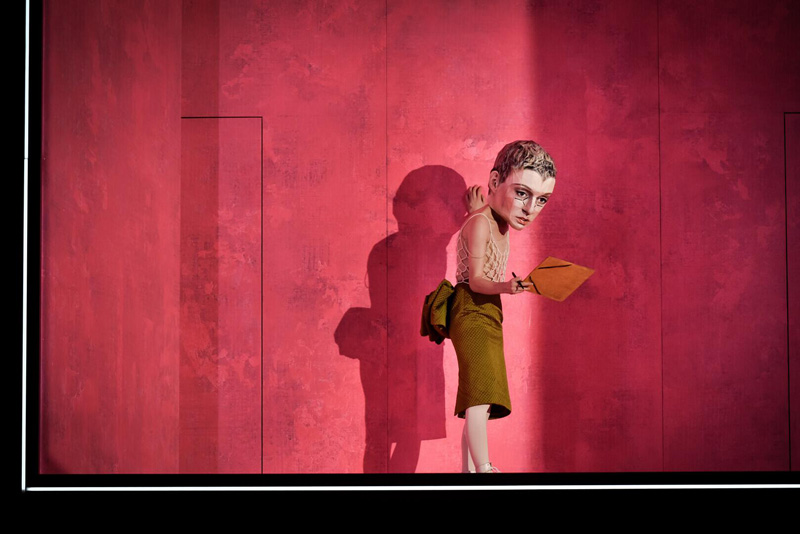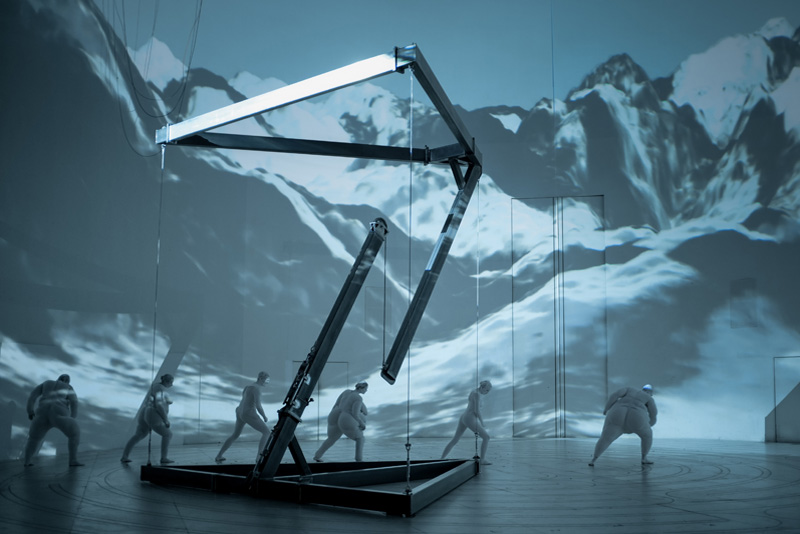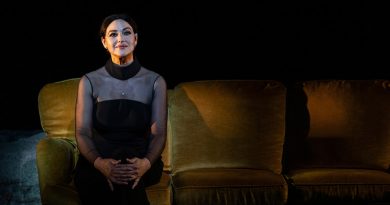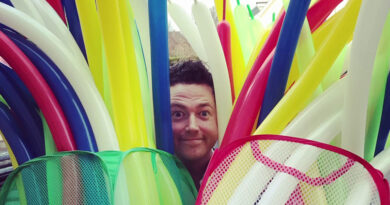Theatertreffen festival, Berlin 2021: Hans-Jürgen Bartsch
For the second time since the outbreak of the Corona pandemic, the Theatertreffen festival has fallen victim to an extended lockdown. Like last year, the ten “remarkable” German language productions, which had been invited to the festival on the recommendation of a jury of seven drama critics, were only accessible online via live stream or on 3sat television, thanks to this channel’s long-standing cooperation with the festival. Three of the invited productions originated in Berlin (two of them at Deutsches Theater), the others in Hamburg, Munich (two), Basel, Vienna, and Zurich (two).

Maria Stuart. Photo credit: Arno Declair.
Being a non-resident correspondent, I missed Friedrich Schiller’s Mary Stuart when it opened at Deutsches Theater during the last season, as well as the other production from this theatre, a stage adaptation of Thomas Mann’s novel The Magic Mountain, which was to open in December but could not be premiered because of the lockdown. I was looking forward to catching up on both at the festival. Alas, it was not to be. I had to be content with watching them on a screen at home.
Friedrich Schiller’s Mary Stuart is a staple ingredient in the repertoire of German theatres. Anne Lenk’s staging at Deutsches Theater is already this theatre’s third production of Schiller’s drama since the beginning of the millennium, following one directed by Thomas Bischoff in 2002 and another directed by Stephan Kimmig ten years later. The current revival opened last October, but the run was cut short by the lockdown after only three performances.

Maria Stuart. Photo credit: Arno Declair.
Mary Stuart is an historic drama in the sense that it features a confrontation in 1587 between Elizabeth I and the pretender Mary Queen of Scots, after the self-proclaimed “Queen of England, Ireland and Scotland” has been sentenced to death for high treason and is awaiting Elizabeth’s decision to confirm the death warrant or to pardon her. The encounter between the two royal ladies, the dramatic highlight of the play, is not borne out by historical facts. (Phyllida Lloyd discusses this elsewhere in an interview with Jeremy Malies.) It is a product of Schiller’s imagination.
The highly original set created by Lenk’s long-time collaborator Judith Oswald – a ceiling-high wall covering the whole width of the stage with open-fronted, garishly-pink painted boxes on three levels cut into it – bears a resemblance to the frontage of a jail rather than to Elizabeth’s residence at Fotheringhay Castle. The boxes resemble prison cells, and this is intended.
In Lenk’s reading, Mary is not the only prisoner. In many ways, Elizabeth and her courtiers are also held captive in isolation, caught up in a web of intrigue, conspiracy, and treachery. In his drama Schiller portrays a world where loyalty, trust, and compassion are unknown attributes among the monarch’s entourage, and Lenk has skilfully translated this ambience into a one-act play of 135 minutes.
The cast has been reduced to eight protagonists – the two royals and six of Elizabeth’s ministers and attendants – who appear in turn in one of the boxes delivering their lines directly to the audience. They do not enter and exit; whenever they are “on”, their box is lit up, and it goes dark again when they have finished. Dialogues are rare and are conducted through the wall separating the cells. Advantage: every line spoken reaches the audience loud and clear. Disadvantage: the actors are limited to minimal gestures and, with two exceptions, cannot interact with each other. They look like (talking) exhibits in a picture gallery. Intended or not, it is an arrangement that ensures compliance with the current social distancing rules even on the stage.
Elizabeth, appearing in a larger box in the centre of the wall, is not the haughty and implacable queen she is usually portrayed as being. Played by Julia Windischbauer, she is a rather sensible and pragmatic woman. But in her role as the country’s ruler she is indecisive, wavering between empathy with her cousin Mary and her duties as a defender of the monarchy and Protestantism against her Catholic adversary’s claim to the throne. Her advisers are of little help: the Earl of Leicester, a careerist and obsequious schemer (Alexander Khuon), advocates Mary’s execution while the Earl of Shrewsbury (Jörg Pose) objects on moral grounds, and also because he fears that a dead Mary would pose a greater threat to the throne than one who is graciously pardoned.
The encounter between the two royals is one of the occasions where two protagonists confront each other directly. Mary (Franziska Machens) has been persuaded to accept the meeting as a last-minute attempt to obtain a pardon. But already her ironic genuflection is taken amiss by Elizabeth, and when she asserts her own right to the throne, arguing that she could claim much bluer blood (which in fact she could), the meeting ends in an angry quarrel. Mary’s fate is sealed. Elizabeth signs the death warrant (wearing a mask to underline that she is exercising an official function where facially-expressed private emotions have no place).

The Magic Mountain. Photo credit: Arno Declair.
The scene where the impetuous young Mortimer (Jeremy Mockridge), driven by religious and sexual fervour, courts Mary and boasts about secretly plotting her escape verges on the comical. It is an example of Lenk’s talent to inject irony and sarcasm into this play which Schiller had subtitled ein Trauerspiel (a tragedy). Her costume designer Sibylle Wallum worked on the same wavelength: Mortimer is sporting a T-shirt with a portrait of Elizabeth printed on it, to conceal his double-dealing from the queen’s entourage. But he underestimates the cunning schemers in the court’s administration. His plot is discovered, and Mortimer has no other option than to commit suicide – which Mockridge performs pathetically as a sacrifice.
Elizabeth ends up deserted and lonely. When she is apprised of her rival’s execution and of new evidence showing that Mary had been sentenced on trumped-up charges, she ignobly tries to escape responsibility by blaming her secretary Davison (Caner Sunar) for having let the warrant fall into the hands of Lord Burleigh, her hawkish chief adviser (Enno Trebs as a sinister control freak). Davison is sentenced to life imprisonment, Burleigh is banished, Shrewsbury resigns, and when Elizabeth calls for her confidant Leicester she is told, “His lordship asks to be excused; he left by boat to France.”
According to the criterion for selecting the productions for the Theatertreffen festival, Sebastian Hartmann’s adaptation of Thomas Mann’s novel The Magic Mountain is certainly “remarkable”, if only for its innovative staging concept. When it became clear during the rehearsals that the premiere would have to be postponed, Hartmann redirected the preparations for a live performance towards an online presentation. Hence, what I watched on Theatertreffen Livestream was not one of the usual online transmissions of a stage performance but a theatrical creation sui generis, especially produced for live-streaming.

The Magic Mountain. Photo credit: Arno Declair.
In his 800-page novel, Mann tells the story of Hans Castorp, a young man from Hamburg who travels to a sanatorium in the Swiss mountains to visit his dying cousin. He had planned to spend three weeks there but stayed seven years, first intrigued, then fascinated and absorbed by this strangely remote universe where time has lost any meaning. Not much of the novel’s storyline or its central theme – the passing of time, actual and perceived – is easily recognizable in Hartmann’s radical transformation from book to live-stream.
The scene is a wide, empty space shrouded in haze with a panorama of snow-covered mountains in the background (set design: Hartmann himself). The actors trudge across the stage in ridiculously oversized bodysuits, their faces and hair smothered with layers of chalk-white greasepaint (costumes: Adriana Braga Peretzki). Lengthy passages from the novel are delivered in no particular order as monologues, some at breakneck speed, making it difficult to follow and leaving the narrators visibly exhausted. As is the fashion nowadays, ample use is made of film and video, and the actors are equipped with wireless microphones. Half a dozen cameras are installed in the auditorium, the wings, and the gridiron. Parallel to the action on stage, we are entertained with views of the empty auditorium (as a reminder of the lockdown), and what is happening in other parts of the building. We also get a bird’s-eye view of the performance down below. Some cameramen mingle with the actors on the stage, filming them in close-up while (successfully) trying to avoid collisions. The visual extravaganza ends with the mighty snowstorm in which Castorp is caught up in while hiking in the mountains.
In an interview, Hartmann announced that the audience will see a quite different version when the play eventually (probably early next year) opens as a live performance.
At the time of writing, Berlin’s theatres have begun to welcome audiences again. Some had skipped the traditional summer recess; others are gradually reopening their doors. Admission is limited to spectators holding a vaccination certificate, and hygiene and distancing rules will continue to apply in the auditorium. Live performances are back again, and hopefully the next report from Berlin will no longer contain references to lockdowns, cancellations, postponements, and live-streaming.









